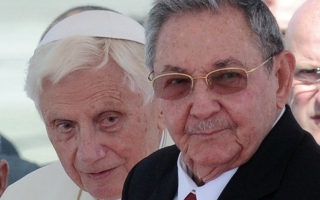
It is possible that the maximum leader of the Catholic Church doesn’t know that when he officiates at the public mass in Civic Plaza* in Havana on March 28, he will not only be offering his blessing to the people of Cuba, but also sealing the first act of Revolutionary Reaffirmation called by the Cuban government under umbrella of a religious celebration, with the consent and approval of the Catholic hierarchy of the Island.
It could not be otherwise because — following the guidelines emanating from the olive-green throne of the supreme pontiff of the Antilles — all Cuban workers and students have been called to attend the event, transportation included, to ensure attendance at the Mass, with no shortage of cases where those heretics who dare to miss the appointment have been threatened with the loss of a day’s pay.
The official orders are clear and precise: At 6:00 the “faithful” (to the government) should be gathered at each collection point and confirm their attendance by signing in on a list that will be kept by a trusted official. It is strictly forbidden “to carry signs or shout Revolutionary slogans,” they must remain “silent” and take the place assigned to them in the Plaza. With the intention of better control over any possible situation that violates the established emotional boundaries, Civic Square has been carefully marked off in a grid, and every ram has his assigned fold so that there will be no agitation in the herd. Correspondingly, each grid has been assigned an unspecified number of law enforcement and political police, who must be suitably dressed in civilian clothes.
In recent days, in an unprecedented move, the administrators of numerous workplaces have circulated sign-up sheets for the commitment to attend the Mass, as if it were any other “combatant march.” Undoubtedly, the government refuses to allow the Plaza, its sacred space of the Revolution, to fill spontaneously with tens of thousands of Cubans from a cause other than the Revolution itself; thus, it is necessary to clarify that — with or without Pope — the site will be filled only by the call of the officiating historicals** of the cult.
In times past, believers were constantly harassed and disenfranchised. In the Old Havana neighborhood of my childhood and adolescence, a handful of young people and children attended the catechism classes at María Auxiliadora Church, and for that reason were nicknamed “the blessed” and were often teased by the children of “Communist” families. This government has never made a public apology for the prolonged and unjustified discrimination of the religious of any denomination; instead, it now presents itself as a champion of religious freedom, as was recently cynically declared by the Cuban Foreign Minister at a press conference.
But the most astonishing part of this whole picture is the quiet complacency of the religious authorities. A few days ago, the archdiocese reacted violently to what they took as the desecration of a temple, and denounced as “illegal” the occupation of the Church of La Caridad by thirteen dissidents with a list of demands they wanted to deliver to the Pope. The severity of the offense was greater because — the church itself said — it was using a space of worship for political issues, which is foreign to the spirit and the role of the Church. So offensive was the intrusion of these people with their demands, that Cardinal Jaime Ortega himself asked the authorities to expel these new Pharisees from the Temple of God.
However, these days it has become obvious that the only politics worthy of the Catholic sacred spaces are those of the Government, as evidenced by the media manipulation, the official calls to mass, and the entire proceedings around the visit of Benedict XVI on the part of the ruling elite. Some Cubans have waited in vain for a note of protest from the Archbishop at such a politicization of what is supposed to be a pastoral visit to reaffirm faith in God, and which, by the work and the grace of the Castro-Catholic romance, has turned out to be — at least in appearance — another march in support to the government.
A great deal of space has already been lost to the Catholic faith in Cuba. We are, in reality, a people more superstitious than religious, more practical than devout, more hedonistic than sacrificing. The ordinary Cuban generally partakes equally of any saint or creed that is useful in the short term, and so among us the utilitarian always exceeds belief in the sacred, so much so that here the sacred often has a certain comic flavor. But, surely, when Benedict XVI lifts off from Cuban soil and returns to the peace and meditation of his Vatican, he will leave behind a people even less Catholic than his predecessor, John Paul II, left behind 14 years ago.
This post is translated from Diario de Cuba.
27 March 2012
Translator’s notes:
*Miriam is using the pre-Revolution name for what is now called “The Plaza of the Revolution.” The square, the buildings and the monuments there were all built before Castro came to power, with the exception, of course, of the cast iron sculptures on two facades, one of Che’s face and one that of Camilo Cienfuegos.
**The survivors of the original Revolutionary Army and the earliest leadership of Fidel Castro’s government are commonly referred to, by themselves and others in Cuba, as “the historicals.”
